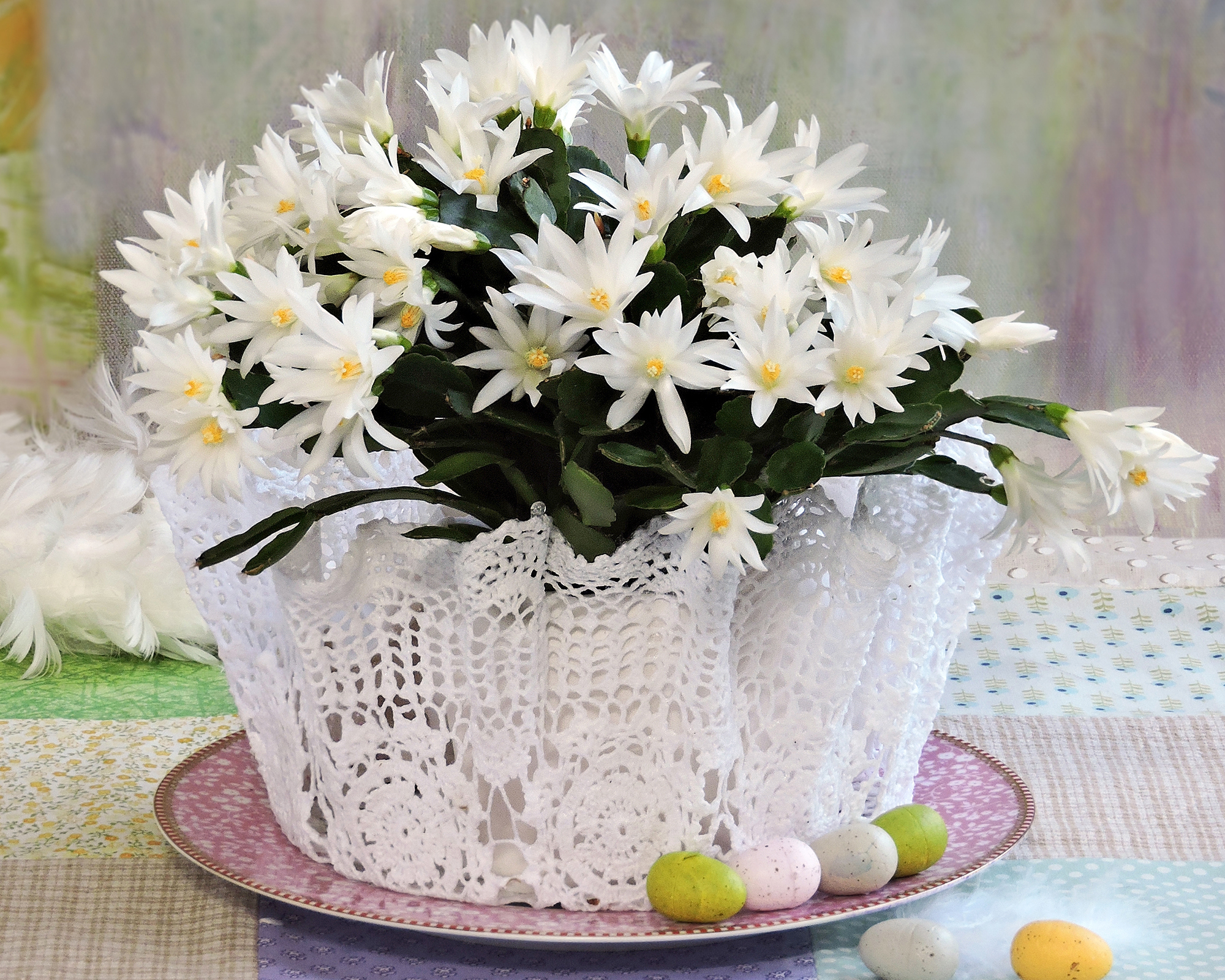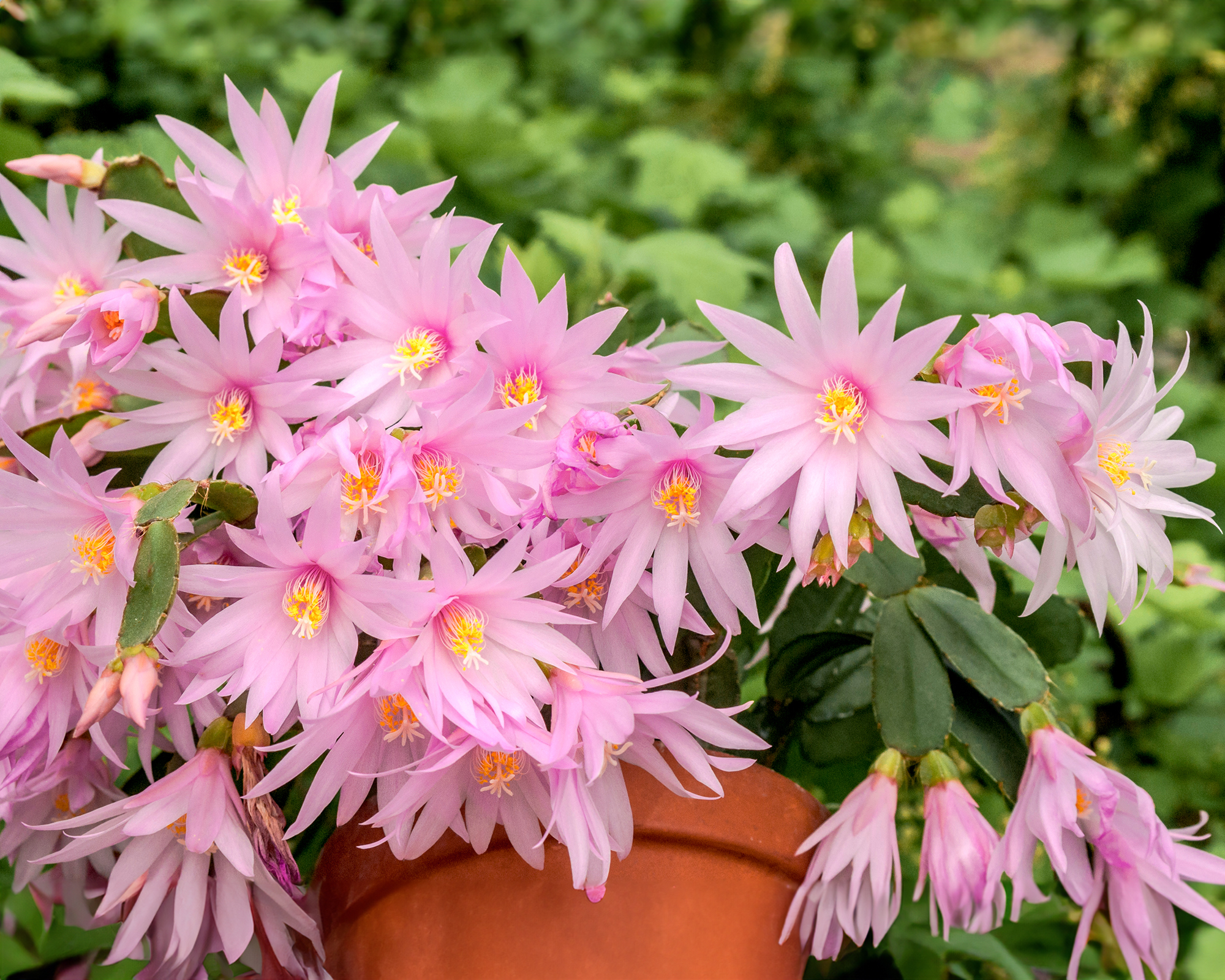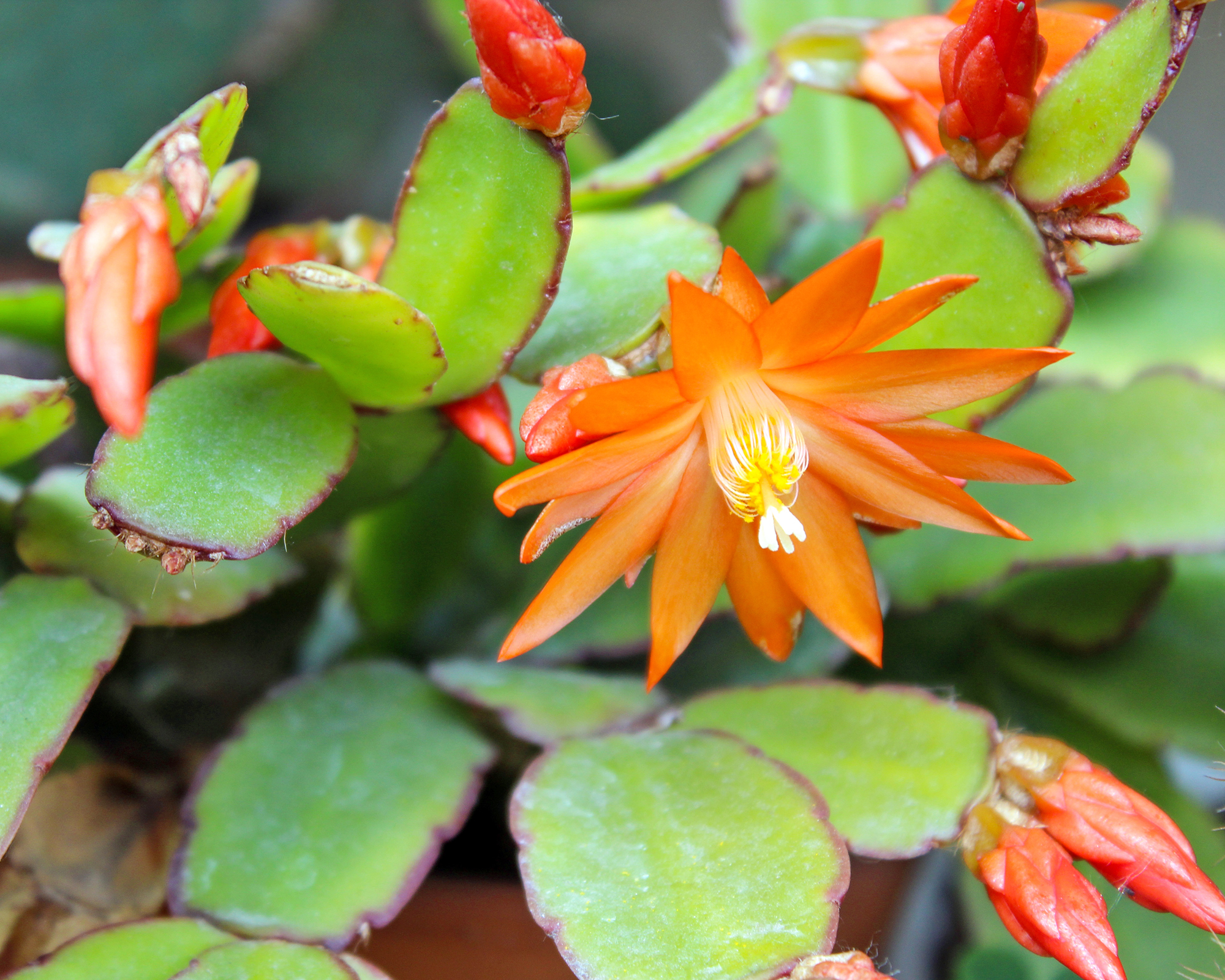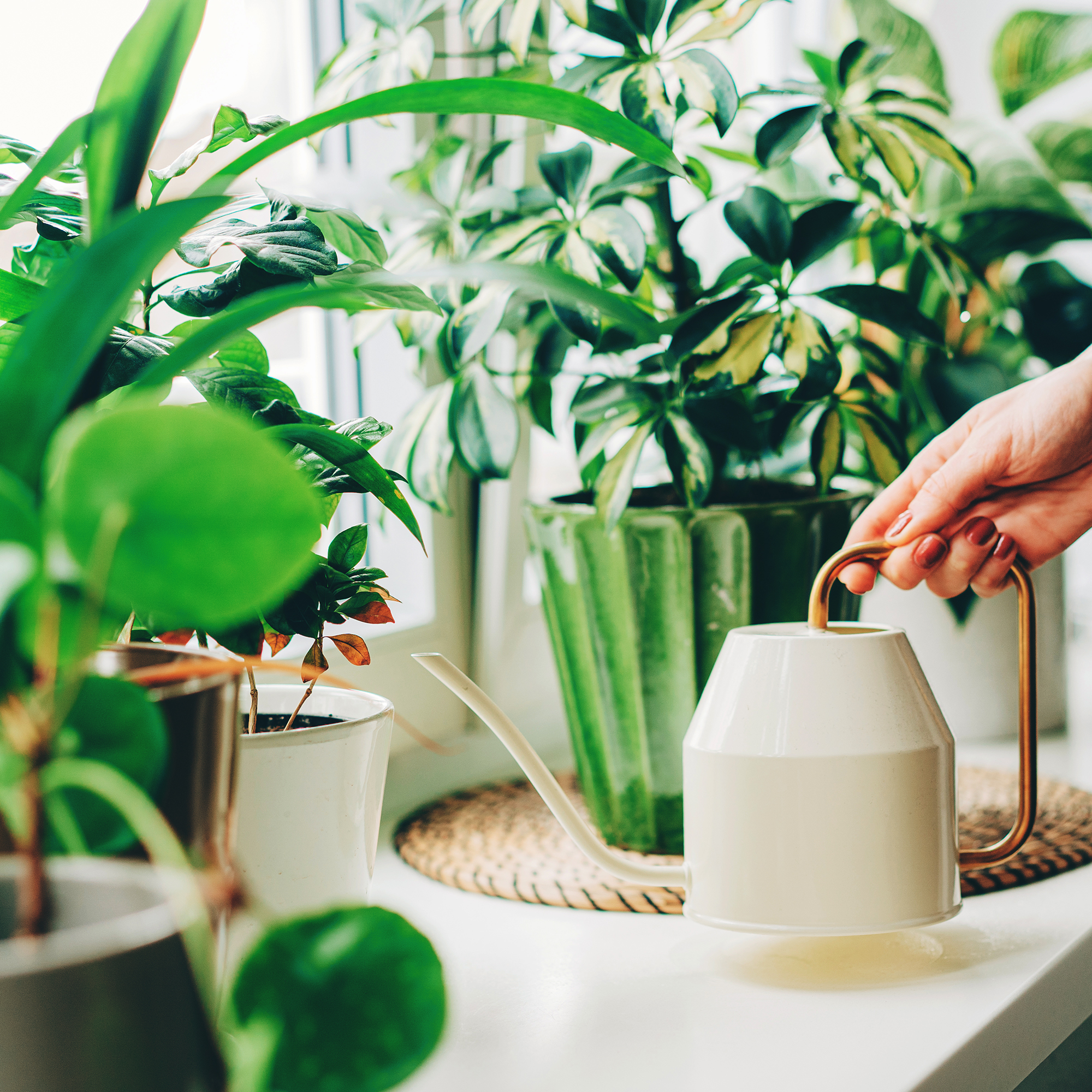Easter Cactus Care Guide: Grow Thriving Houseplants With Stunning Spring Blooms
The Easter cactus is a sight to behold in spring when it bursts with a profusion of star-shaped flowers. Learn how to nurture this beautiful houseplant.

Amy Draiss
The Easter cactus (Rhipsalidopsis gaertneri) is the underdog of the holiday cactus world, and unfairly so. Its star-shaped blooms, which come in myriad colors, outshine those of its cousins, Christmas and Thanksgiving cacti, and arrive in spring, offering a different look to the ubiquitous potted spring bulbs. Good Easter cactus care is essential to encourage flowers, and involves recreating the plant's natural dormant period in the home.
One of the big three types of holiday cactus, the Easter cactus is the most sensitive to care lapses, which is perhaps why it is the least common. However, this group of houseplants is low maintenance, and so while looking after Easter cactus is a little more challenging than Christmas cactus care and Thanksgiving cactus care, it's still not difficult.
Good care of Easter cactus is worth the effort in the long term, as the plants can live for decades. Plus, they're easy to propagate, so new plants can be passed on to family and friends as thoughtful Easter gifts.

What Does an Easter Cactus Look Like?
You can spot an Easter cactus by its leaves, which have smooth, rounded leaf edges with no notches, and its star-shaped flowers, which come in a range of colors, including white, red, orange, peach, lavender, and pink.
Quick Easter Cactus Facts
Botanical name: Rhipsalidopsis gaertneri
Height: 6-12 inches (15-30cm)
Spread: 18-24 inches (45-60cm)
Sun exposure: Bright, indirect
Soil requirements: Well-draining potting medium
Hardiness zones: USDA Zones 10-12
When to plant: Spring or summer
Even following its bloom, the plant has an interesting appeal in its unusual shape. The segments are added onto by new growth, creating a rickety stacked appearance.
While Thanksgiving and Christmas cacti belong to the Schlumbergera family, Easter cactus is in the Rhipsalidopsis family. However, its taxonomy has been long debated by botanists, causing the plant to have been reclassified several times over the last century. Easter cactus has also been known as Schlumbergera gaertneri and Hatiora gaertneri.
For the layperson, all you really need to know is that the three plants are native to Brazil and have a similar appearance and care requirements. However, there are some differences, the most obvious one being their bloom time. While Thanksgiving and Christmas cacti flower in fall and winter, the Easter cactus blooms in late winter or spring.
Sign up for the Gardening Know How newsletter today and receive a free copy of our e-book "How to Grow Delicious Tomatoes".

Easter Cactus Care
It's not difficult to care for an Easter cactus for most of the year, but encouraging those stunning spring flowers takes a bit of planning. Getting an Easter cactus to bloom involves creating a dormant period, which you need to start two or three months in advance.
Unlike desert-dwelling cacti, which have adapted to dry heat and full sun, the Easter cactus is a tropical succulent that resides in coastal mountainous rainforests in Brazil. There, the conditions are warm and humid, and the canopy of trees shelters the understorey from direct sunlight.
Rather than growing out of the soil, Easter cactus is an epiphytic plant, which means it grows on trees, using aerial roots to absorb moisture and nutrients from the air and surrounding debris.
The rainforest doesn't get freezing cold in winter, but up in the mountains it definitely gets cooler and the days grow shorter. At this time, Easter cactus goes into a stage of dormancy for several weeks before reawakening in late winter to early spring with a new set of buds.
To successfully grow Easter cacti, you need to mirror the plant's natural growing conditions by providing similar light, temperature, moisture, and nutrient levels as it receives in its native habitat.

Light Requirements
Easter cacti perform best in bright light, but not direct sunlight. Ideally place the plant next to an east or north-facing window. If the light is too bright, then filter it using a sheer curtain.
In order to encourage flowering, Easter cactus requires a period of short days, with long dark nights of at least 12 hours. This must last for 8 to 12 weeks before flowering. During winter, move the plant to a cool room that is not artificially lit in the evening or early morning.
If this is not possible, you can place the plant in a closet each night or cover it with a box or breathable bag to shut out the light.
Temperature Range
Throughout most of the year, Easter cactus flourishes in daytime temperatures of around 60 to 75°F (16 to 24°C) and slightly cooler nighttime temperatures of 55° to 65°F (13 to 18°C).
However, to encourage flowering, the plant requires a cool period during dormancy. When you start the short-day cycle, the plant must be kept in a cool, unheated room where it can rest with daytime temperatures between 60 to 65°F (16 to 18°C) and nighttime temperatures of 50 to 60°F (10 to 15°C). But ensure the plant will not be affected by drafts.
In late winter, you can gradually acclimatize your Easter cactus to room temperature, avoiding any sudden dramatic temperature changes. Then the plant should begin producing buds.

How Often to Water an Easter Cactus
Watering an Easter cactus is a careful balance. As tropical plants, they need some moisture in the soil, but excess water will lead to fungal issues, root rot, and eventually plant death. Take the same precautions as when watering Christmas cactus plants.
Expect to water plants once or twice a week, but rather than doing it to schedule feel the soil. Push your index finger into the soil down to the second knuckle. If the top couple of inches feels dry, then water the plant.
When watering Easter cactus, give the soil a good flush through and let it fully drain out before returning the pot to its saucer or outer pot.
In winter, as the plant enters its dormant stage, you will need to water less often. Check the soil for moisture every few days.
Humidity is also an important way for Easter cactus to receive moisture, and plants require 40-60% relative humidity. To raise humidity for houseplants, use a houseplant humidifier or sit the pot on a tray of pebbles filled with water, not allowing the soil to be immersed in the water.
Fertilizing Easter Cactus
Fertilize Easter cactus plants once a month after they have finished blooming with a balanced 10-10-10 formula diluted to half strength. Continue fertilizing until the fall, then cease prior to the plant entering its dormant phase.
Easter cacti have high magnesium requirements, so it's a good idea to apply Epsom salts every month or two. Dilute one teaspoon of Epsom salts per gallon of water and apply in an alternate week to fertilizing.

Repotting an Easter Cactus
Repotting an Easter cactus is only necessary every three years or so, as the plants like to be fairly pot-bound. Eventually, however, the plant will outgrow its container, and the potting mix will break down and lose its nutrients. Perform this task only after plants have finished flowering.
Transition the plant to only a slightly bigger pot size, and ensure it has adequate drainage holes. You will also need to use a well-draining potting mix. Take the opportunity while repotting to tidy the plant, prune away any dead material, and take cuttings to grow new plants.
Easter Cactus Soil
Check the advice for Christmas cactus soil before repotting your Easter cactus, as their requirements are the same. While a regular houseplant potting mix can be used, it needs to be well draining, so mix in some perlite or vermiculite. Alternatively, use a cacti or succulent potting formula.
Pruning Easter Cactus
Wait until your Easter cactus has finished blooming, then carry out a light pruning. Not only will this tidy and shape the plant, but it will encourage the formation of new stems.
Either use sharp scissors or break off the stems by twisting between the segments. To help the plant fill out, you want to take just one or two segments from the end, losing no more than one-third of the plant each year.
While your Easter cactus is blooming, deadhead spent flowers to encourage more buds to form. They should twist off easily with your fingers.

Propagating Easter Cactus
Propagating Easter cactus plants is best done by taking root cuttings. It's easy to do, but it takes a couple of years before the new plants will start flowering, so bear this in mind when growing them as gifts.
- Cut fresh, healthy stems, taking 2-5 sections. It's important to use sharp, sterilized pruners or scissors to minimize damage.
- Place the cuttings on a plate or paper towel and set them in a dry location for a week, to allow the cut ends to callus over. While not essential, dusting the ends with fungicide will help prevent disease.
- Fill small pots with potting mix blended with vermiculite, perlite, or sand.
- Insert the callused ends of the cuttings into the potting mix, cover the pots with plastic bags, and move to a spot where they can receive bright, indirect light. Once a day, remove the bags for an hour to allow the cuttings to breathe.
- It will take around three weeks for the cuttings to root. At this stage, you can remove the bags and care for your young plants, following the advice in this guide.
Common Problems
Easter cacti are not prone to many problems, but they can occasionally happen, usually due to incorrect care. Here are some issues to watch out for:
- Root rot is the biggest concern and is usually symptomatic of an overwatered Easter cactus, or poor drainage in the potting mix. The leaves will usually turn yellow and the roots will begin to rot, turning black and mushy. This will be accompanied by a putrid smell. Quickly take action to trim away diseased roots, wash the remaining roots, and allow the plant to dry out. Applying a natural fungicide may help treat the rot. Let the plant air out on the counter overnight before repotting the next day in a fresh well-draining potting mix. You should take steps to avoid root rot by only watering plants once the top layer of soil has begun to dry out.
- An underwatered Easter cactus should also be avoided. If the soil feels dry, and the leaves are lackluster, limp, and brittle, then a lack of moisture is likely the cause.
- Wrinkled leaves on Easter cactus are another sign of underwatering.
- Yellow Easter cactus leaves are usually caused by overwatering, but may also be due to too much direct light or a lack of fertilizing.
- Easter cactus dropping leaves may be due to overwatering, drainage issues, or incorrect temperatures.
- Bud drop may be caused by several factors, such as incorrect watering, light levels, or sudden temperature changes.
- A wilting Easter cactus is probably the result of underwatering or excessive light. However, if the soil is moist, check for root rot.
Pests
Common pests that can trouble Easter cacti include mealybugs, spider mites, scale insects, and fungus gnats. Pests are most likely to affect plants that spend the summer outdoors.
When bringing it back inside, isolate the plant and inspect it for signs of pests. If present, wipe the leaves with a cotton ball moistened with alcohol. Alternatively, a homemade spray using neem oil is very effective. Spritz the plant every few days until all pests are gone.
More Houseplant Inspiration
- Browse stylish planters in the Gardening Know How Shop – including self-watering designs and indoor/outdoor pots.
- Discover 8 rare orchids that make stunning houseplants – some are surprisingly easy to grow.
- Enjoy spectacular blooms all year with the longest-flowering houseplants.
- Find out how to choose perfect houseplant combinations for every room in your home.

Melanie is an experienced gardener and has worked in homes and gardens media for over 20 years. She previously served as Editor on Period Living magazine, and worked for Homes & Gardens, Gardening Etc, Real Homes, and Homebuilding & Renovating. Melanie has spent the last few years transforming her own garden, which is constantly evolving as a work in progress. She is also a passionate organic home grower, having experimented with almost every type of vegetable at some point. In her home, Melanie tends to an extensive houseplant collection and is particularly fond of orchids.
- Amy DraissDigital Community Manager
